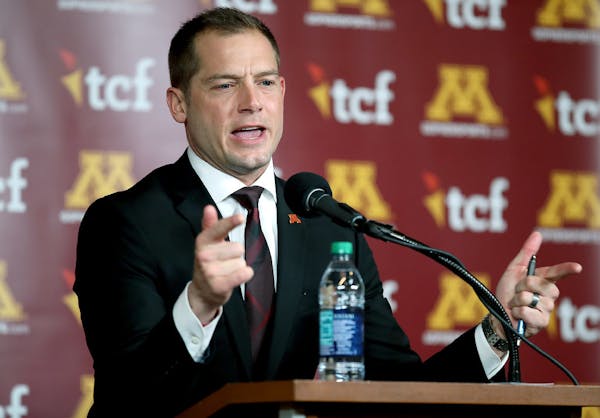We have been informed that Phillip John Fleck performed quite an amazing feat by putting together a 25-player recruiting class in the four weeks after being hired as the Gophers football coach.
The amazement factor should be lessened by the fact Fleck stole nine of those players from his former school, Western Michigan, where he had been recruiting those players and getting commitments for months, maybe a couple of years.
For all the bravado, the Gophers wound up 12th in the Big Ten, beating out only Purdue and Indiana.
Purdue has become a Big Ten bottom feeder in recent times and had a new coach in Jeff Brohm from Western Kentucky. Indiana has been a traditional bottom feeder, and went spiraling downward again when Kevin Wilson, a strong recruiter, resigned and the Hoosiers replaced him with defensive coordinator Tom Allen in December.
The Gophers wound up rated 57th nationally, one spot above Memphis, the first non-Power 5 team to appear in the rankings.
They also failed the traditional Reusse test for recruiting rankings:
The Gophers finished four places behind Iowa State. For me, Iowa State has long stood as the Mendoza Line for football recruiting. If Minnesota or any other major conference team finishes below Iowa State, it officially has a lousy recruiting class.
For those into percentiles, Phillip John's first class finished in the bottom 12.3 per cent of Power 5 programs in the rankings. That's what happens when you steal 36 percent of your players from the MAC, where a three-star recruit is considered elite rather than routine.
The true amazing work in Big Ten recruiting was done by D.J. Durkin in his second season at Maryland. The Terps finished 18th overall and fourth in the Big Ten, behind Ohio State, Michigan and reinvigorated Penn State.
The entire Gophers recruiting class consisted of three-star players -- which is good enough to compete in the Big Ten West, if you can coach, as could Jerry Kill, Tracy Claeys and their staffs.
Nebraska was the highest-rated West team at No. 23, fifth in the Big Ten. Iowa and Wisconsin were bunched at Nos. 40 and 41.
As Chip Scoggins suggested in his Thursday column, the East and the West looked like an elephant and a squirrel on a seesaw when the divisions were aligned geographically in 2014. It looks even more that way now that James Franklin has gotten Penn State back on its feet.
Wisconsin has been a power in the West based on coaching rather than blue-chip recruiting. Iowa's successful seasons have come in the same manner. Mike Riley doesn't look like the coach to put Nebraska back in the picture as a national contender.
The East would be impossible for the Gophers. The West is winnable.
The Gophers went to Wisconsin at the end of the 2014 regular season with a chance to win the Big Ten West. The Gophers still had a shot with two weeks left in 2016 and defeated Northwestern 29-12 in the last home game. By that Saturday's end, they were eliminated through a tie-breaker, and then lost to Wisconsin for the 13th straight time in the Big Ten finale.
I bring this up after engaging some Gophers followers in a Twitter dialogue on Wednesday night. I find Fleck to be even more nonsensical with his rhetoric than was Brewster, and have made that clear in the candid world of Twitter.
One Tweeter responded that if Fleck gets the Gophers to the Big Ten championship game in the next four or five years, he doesn't care how much bull is slung by Phillip John.
Four or five years to win the Squirrel Division of the Big Ten?
That's quite a burden to place on a coach making $3 million-plus annually and one year from moving into a $170 million athletic complex that will be largely dedicated to football.
How about making that, "If Fleck has the Gophers in the Big Ten championship game in a year or two,'' you will forgive him all the bull slinging?
Another Twitter respondent said the standard for Fleck in 2017 should be to win seven games.
The Gophers won nine in 2016 and fired the coach, and with a bit more difficult schedule in 2017, winning seven should be considered a success?
This isn't Lou Holtz taking over for Joe Salem for the 1984 season. This isn't Glen Mason taking over Jim Wacker for the 1997 season. This isn't Jerry Kill taking over for Tim Brewster for the 2011 season.
This isn't a rebuild. There's a base of talent here. Even without 10 suspended players, it's a team that impressively won a bowl game, much to the dismay of a university president and athletic director who knew that night in San Diego they were going to fire Claeys and bring in Fleck after Western Michigan played in the Cotton Bowl.
The other day, I heard Phillip John in a radio interview spouting that failure was growth. If that's the case, his first Gophers result is definitely growth -- since finishing 12th in the Big Ten and four notches below the Mendoza Line nationally in recruiting is failure.

Live from Target Center: Timberwolves vs. Suns game updates
![Vikings running back Dalvin Cook (33) watched during training camp Wednesday. ] ANTHONY SOUFFLE • anthony.souffle@startribune.com](https://arc.stimg.co/startribunemedia/ZHKH7NZVBNL2RFYGUCXADSN6IA.jpg?h=91&w=145&fit=crop&bg=999&crop=faces)
